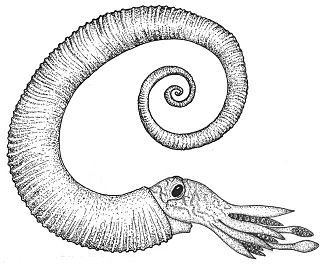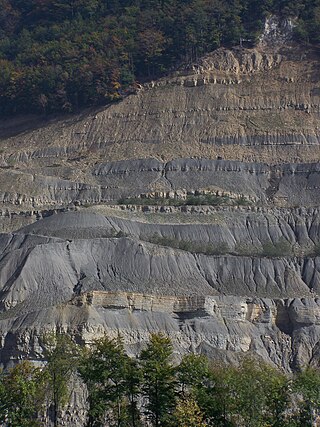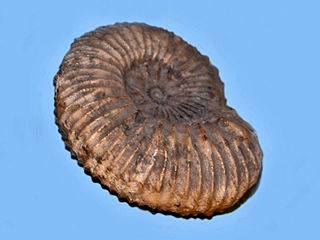
Ammonoids are a group of extinct marine mollusc animals in the subclass Ammonoidea of the class Cephalopoda. These molluscs, commonly referred to as ammonites, are more closely related to living coleoids than they are to shelled nautiloids such as the living Nautilus species. The earliest ammonites appeared during the Devonian, with the last species vanishing during or soon after the Cretaceous–Paleogene extinction event.

The Ancyloceratina were a diverse suborder of ammonite most closely related to the ammonites of order Lytoceratina. They evolved during the Late Jurassic but were not very common until the Cretaceous period, when they rapidly diversified and became one of the most distinctive components of Cretaceous marine faunas. They have been recorded from every continent and many are used as zonal or index fossils. The most distinctive feature of the majority of the Ancyloceratina is the tendency for most of them to have shells that are not regular spirals like most other ammonites. These irregularly-coiled ammonites are called heteromorph ammonites, in contrast to regularly coiled ammonites, which are called homomorph ammonites.

Ammonitida is an order of ammonoid cephalopods that lived from the Jurassic through Paleocene time periods, commonly with intricate ammonitic sutures.
In the geologic timescale, the Bajocian is an age and stage in the Middle Jurassic. It lasted from approximately 170.9 ±0.8 Ma to around 168.2 ±1.2 Ma. The Bajocian Age succeeds the Aalenian Age and precedes the Bathonian Age.
In the geologic timescale the Bathonian is an age and stage of the Middle Jurassic. It lasted from approximately 168.2 ±1.2 Ma to around 165.3 ±1.1 Ma. The Bathonian Age succeeds the Bajocian Age and precedes the Callovian Age.
In the geological timescale, the Berriasian is an age/stage of the Early/Lower Cretaceous. It is the oldest subdivision in the entire Cretaceous. It has been taken to span the time between 145.0 ± 4.0 Ma and 139.8 ± 3.0 Ma. The Berriasian succeeds the Tithonian and precedes the Valanginian.
In the geologic timescale, the Valanginian is an age or stage of the Early or Lower Cretaceous. It spans between 139.8 ± 3.0 Ma and 132.6 ± 2.0 Ma. The Valanginian Stage succeeds the Berriasian Stage of the Lower Cretaceous and precedes the Hauterivian Stage of the Lower Cretaceous.
In the geologic timescale, the Callovian is an age and stage in the Middle Jurassic, lasting between 165.3 ± 1.1 Ma and 161.5 ± 1.0 Ma. It is the last stage of the Middle Jurassic, following the Bathonian and preceding the Oxfordian.

The Oxfordian is, in the ICS' geologic timescale, the earliest age of the Late Jurassic Epoch, or the lowest stage of the Upper Jurassic Series. It spans the time between 161.5 ± 1.0 Ma and 154.8 ± 0.8 Ma. The Oxfordian is preceded by the Callovian and is followed by the Kimmeridgian.
In the geologic timescale, the Kimmeridgian is an age in the Late Jurassic Epoch and a stage in the Upper Jurassic Series. It spans the time between 154.8 ±0.8 Ma and 149.2 ±0.7 Ma. The Kimmeridgian follows the Oxfordian and precedes the Tithonian.

Lytoceratina is a suborder of Jurassic and Cretaceous ammonites that produced loosely coiled, evolute and gyroconic shells in which the sutural element are said to have complex moss-like endings.

Ammonitina comprises a diverse suborder of ammonite cephalopods that lived during the Jurassic and Cretaceous periods of the Mesozoic Era. They are excellent index fossils, and it is often possible to link the rock layer in which they are found to specific geological time periods.

Hibolithes is a genus of belemnite that lived from the Middle Jurassic to the Early Cretaceous, and has been found in Antarctica, Greenland, Iran, Europe, South America, and New Zealand. In 2020, this genus was found in the Pedawan Formation in Sarawak, on the island of Borneo (Malaysia).

Perisphinctoidea, formerly Perisphinctaceae, is a superfamily of Middle Jurassic (Bajocian) to Lower Cretaceous (Barremian) ammonites, commonly with evolute shells with strong ribbing that typically divides about mid flank before crossing the venter.
Kachpurites is an uppermost Jurassic (Tithonian) ammonite included in the perisphincacean family, Craspeditidae; although some classifiers put the Craspeditidae a subfamily in the Polyptychitidae. The shell of Kachpurites is subinvolute with a rounded section and bears low, close spaced, moderately sinuous ribs.
Dvuyakornaya Formation is a geological formation from the Cretaceous period in Crimea, south of Yalta. Remains found there include: ammonites, such as Berriasella, and brachiopods.

Lytoceras is an ammonite genus that was extant during most of the Jurassic and Cretaceous periods, and is the type genus for the family Lytoceratidae. These cephalopods were fast-moving nektonic carnivores.

Cephalopod egg fossils are the fossilized remains of eggs laid by cephalopods. The fossil record of cephalopod eggs is scant since their soft, gelatinous eggs decompose quickly and have little chance to fossilize. Eggs laid by ammonoids are the best known and only a few putative examples of these have been discovered. The best preserved of these were discovered in the Jurassic Kimmeridge Clay of England. Currently no belemnoid egg fossils have ever been discovered although this may be because scientists have not properly searched for them rather than an actual absence from the fossil record.
This list, 2014 in molluscan paleontology, is a list of new taxa of ammonites and other fossil cephalopods, as well as fossil gastropods, bivalves and other molluscs that have been described during the year 2014.

Kosmoceratidae is an extinct ammonite family from the Callovian to Early Cretaceous.











